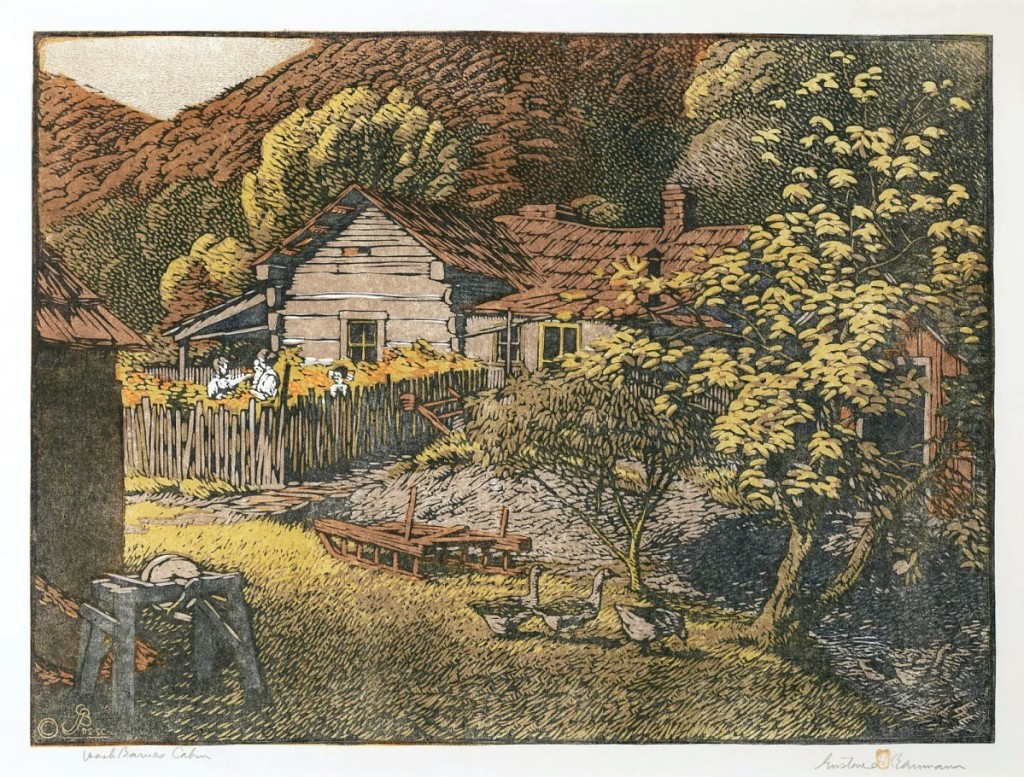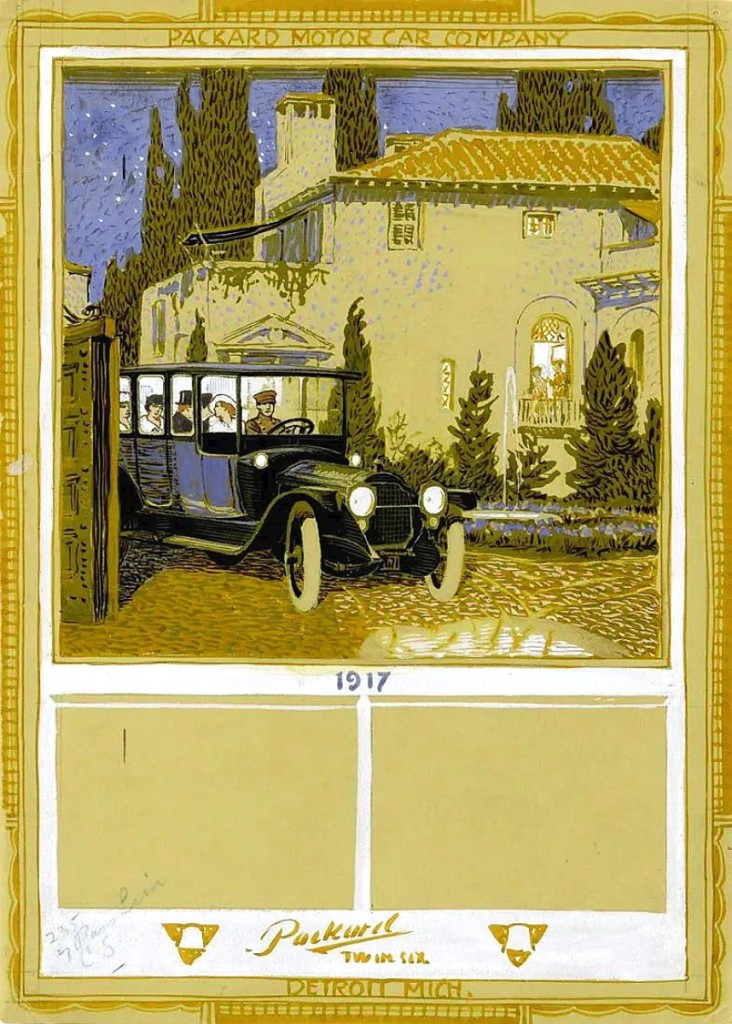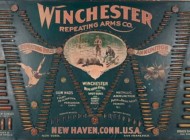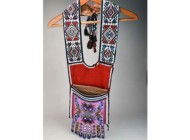-1024x764.jpg)
“Harden Hollow” was among the large-scale prints Baumann created in 1912-13, advertising them as suitable for classrooms. The format was not commercially successful for the artist, though it was certainly a feat in woodblock technique as they were some of the largest multiblock prints created in America to that point. “Harden Hollow,” 19- 5⁄8 by 26- 3⁄8 inches, sold for $28,800.
Review by Greg Smith, Photos Courtesy Santa Fe Art Auction
SANTA FE – A dedicated sale to Santa Fe’s famed woodcut artist, Gustave Baumann, was held at Santa Fe Art Auction on December 11. The auction of 61 lots was 100 percent sold as it grossed more than $725,000.
“Baumann is an iconic part of New Mexico,” Santa Fe Art Auction’s president Gillian Blitch said. “His images have come to be representative of what everybody loves about this place. He was a master printmaker, I don’t think there’s anyone that compares with his skill in woodcut.”
Born in Germany in 1881, Baumann emigrated to the Chicago area when he was 10 years old. He began his art training at age 16 when he got full-time work as an apprentice at an engraving house. By night, the aspiring artist attended classes at the Art Institute of Chicago. In 1903, Baumann opened his own advertising studio where his skills in engraving and graphic design attracted enough clients that he was able to save $1,000. This afforded him a pilgrimage to study at Kunstgewerbeschule, the School of Arts and Crafts, in Munich. It was here that the artist’s foundational love of landscapes and nature took hold. Baumann’s return home in 1906 saw a continuance of his commercial art career as he developed a more personal style in woodblock prints, which he created and sold in editions. By 1909 and with a more solid reputation, he moved to Brown County, Indiana, along with several other Chicago artists, where he joined the Brown County Art Colony headed by Adolph Schulz and TC Steele. His works from Brown County are considered to be among his earliest mature artistic pursuits, the fruits of which were fleshed out in major exhibitions like the Paris Salon and a gold medal in printmaking at the Panama-Pacific International Exposition in San Francisco in 1915. A year later, Baumann organized the first national exhibition of color woodcuts by American artists at the Art Institute of Chicago.
Baumann’s story in Santa Fe began before 1918 when he traveled west to Taos, N.M., to visit his Chicago artist friends Walter Ufer, Victor Higgins and Martin Hennings, who eventually joined the Taos Society of Artists. Finding the town too small, Baumann settled in Santa Fe in 1918, where he would remain for more than 50 years until his death in 1971. Baumann was elected an associate of the Taos Society of Artists and was a founding member of the Society of New Mexico Painters and the Santa Fe Art Club. His involvement in the arts community of Santa Fe was profound and vigorous.
Baumann’s cypher was a hand-to-heart, a symbol developed early in his career as the artist endeavored to make his work affordable to all – he never charged more than $100 per print. That market is, simply put, a relic, as seen in the prices achieved for the 61 lots on December 11 in the artist’s adopted hometown.

The sale was led at $31,200 by “Wash Barnes Cabin,” a 1912 woodblock from an edition of 50 that the artist completed in Brown County, Indiana, where he joined an artist colony. Created in a large format, Baumann exhibited this, “Harden Hollow” and “Plum and Peach Bloom” at the Panama-Pacific International Exposition in San Francisco in 1915, earning himself a gold medal in printmaking.
All of the works in the sale came from a private collection in New Mexico, which preferred anonymity. Many of them had come into that collector’s hands by means of a Denver collection and their total amounted to one of the largest collections of Baumann prints in existence.
“This sale was special,” Blitch said. “To have 61 pieces in the same room is quite remarkable. The strength of the collection was its scope, from the very early work to the latest and through those middle years.”
Santa Fe Art Auction set a record for any Baumann print just a month and a half ago in its November 5 sale when the firm sold the artist’s 1956 color woodcut “Processional” for $42,000. It would not top that result on December 11, but the prices were nevertheless consistently strong.
An Indiana scene would find the sale’s apex when “Wash Barnes Cabin,” a 1912 woodblock print from an edition of 50, sold for $31,200. Of the subject, the auction house wrote, “Washington and ‘Ma’ Barnes have become part of the folklore of Brown County. As one story goes, the couple physically divided their cabin rather than getting a divorce. Mary (‘Ma’) Barnes lived in the front of the cabin and Wash in the back. When Wash died, his body had to be taken out of a window, as Ma would not allow him to pass through the front door.” The print was one of five large-scale woodcuts that Baumann created between 1912 and 1913, which he advertised as suitable for classroom decoration. “Wash Barnes Cabin” measured 19¾ by 26-5/8 inches. When this series was created, these were some of the largest multiple block color woodcuts ever created in America.
Another large-scale print from this series was “The Mill Pond,” dated 1913 and measuring 24-3/8 by 33¾ inches, that sold for $21,600. It depicts Benjamin Cox’s gristmill southeast of Nashville, Ind., which burned down during Baumann’s time there.
Another of the large-scale works was “Harden Hollow,” a 1912 woodcut done in an edition of approximately 20 that brought $28,800. This, along with “Wash Barnes Cabin” and one other, were among the three prints exhibited at the Panama-Pacific Exposition in 1915 that earned the artist a gold medal.
As foundational as the Indiana scenes were, the artist’s palette changed dramatically in 1918 upon his move west, and those scenes commanded the highest volume.

Five original tempera and ink on paper works came from Baumann’s days as a commercial artist. In 1916, the Packard Motor Car Company commissioned him to create a calendar, which they produced to show off the Twin-Six. The originals sold from $9,000 at the bottom to $16,800 for this night scene.
“The New Mexico series is always so desirable and important. We got amazing prices on those,” Blitch said. These scenes, dating from the 1920s and 1930s, document a changing cultural landscape. Selling for $14,400 was “Beginning of the Fiesta,” a 1924 print reeditioned in 1931-32. The Pueblos had only begun allowing outsiders to witness their ceremonies in 1918, something Baumann was drawn to. The print likely depicts the Deer Dance at the Taos Pueblo, a Christmas morning ritual. “Chile con Cabra,” also executed in 1924, depicts a man on the streets of the pueblo pulling a reticent goat into town – peppers with goat sounds like a local dish. The print sold for $15,600. At $31,200, “Sanctuario Chimayo” was the second highest grossing lot in the sale. The sanctuary reportedly held a round pit with dirt believed to have healing powers. The artist said, “The Sanctuario was a place to inspire reverence even in the non-believer. Worshipers with secret wishes come from far places to light a candle before the altar asking that their prayers be granted as the wax drips onto the adobe floor.” Just behind at $26,500 was “San Geronimo Taos,” a woodcut that depicted the feast day of San Geronimo on September 30 each year.
Among the rarities in the sale was “The Patio [Watch at the Gate],” created in 1919 just a year after Baumann settled in New Mexico. Blitch said, “It’s rare, it’s early, it’s Taos. We don’t know if it’s ever been for sale before.” It sold for $7,200.
Harkening back to Baumann’s days as a commercial artist, the sale offered five original tempera and ink on paper works plus one woodcut that he created in 1916 for a calendar commissioned by the Packard Motor Car Company. The run illustrated the company’s Twin-Six automobile in various landscapes through the different months of the year. Its final product, the lithograph calendar, is in a number of museum collections. The originals sold from $9,000 to $16,800.
Completed in 1962, “Hidden Meaning” was the latest work in the sale from the artist. It included both print and its corresponding block and sold for $5,520. This was the last editioned print that the artist ever produced. In the artist’s catalogue raisonné by Chamberlain, Green and Leech, Baumann’s daughter, Ann, remarked that this image would appeal only to the artist’s psychiatrist friends.
All prices reported include buyer’s premium. For information, www.santafeartauction.com or 505-954-5858.


.jpg)












.jpg)



